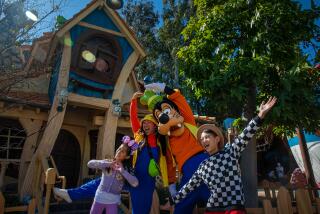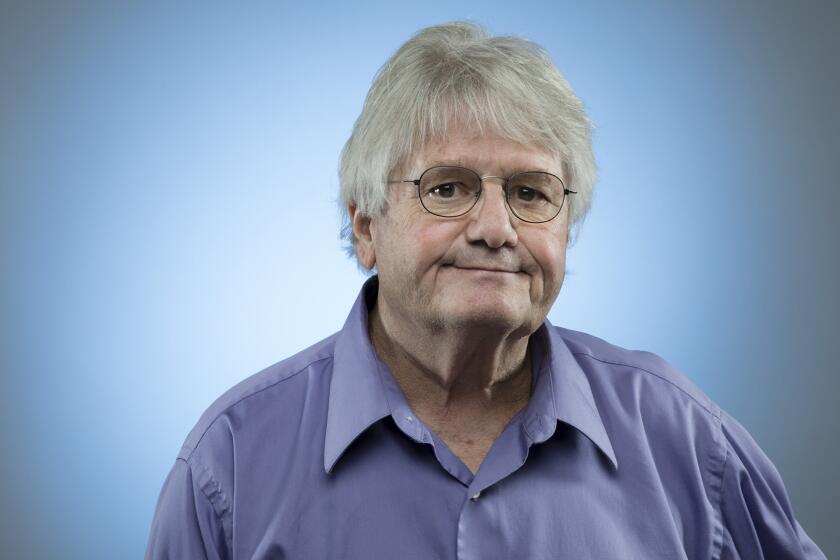Blaine Gibson dies at 97; prominent sculptor, animator at Disney
When Blaine Gibson sent a letter to the Disney animation studio in the late 1930s inquiring about a job, he was told he would have to take an art test by mail.
Gibson, who grew up on a small farm in Colorado, did the required drawing exercises. And for the free-drawing section, he sketched a boy milking a cow with one udder squirting directly into the mouth of a cute kitten.
The sketch sealed the deal. The studio not only offered him a job but asked him to sign a release so it could use the drawing.
Gibson, 97, who animated numerous film sequences and sculpted some of the best-known features of the Disney theme parks — including characters in the Pirates of the Caribbean and Haunted Mansion attractions, and the bronze statue of Walt Disney holding the hand of Mickey Mouse — died Sunday at his home in Montecito.
His son, Wes, said he succumbed to age-related conditions. The day before he died, he watched “101 Dalmatians,” one of the films on which he had worked as an animator, with his grandson, also named Blaine.
Gibson worked for the studio for more than 40 years, retiring in 1983 but returning to add sculptures to Disney World’s Hall of Presidents as new presidents were elected.
One of the best-known sculptures of his career was an uncanny likeness of Abraham Lincoln that debuted at the 1964 New York World’s Fair. Working from a life mask and images of the Civil War president, he created a figure that was equipped with mechanical and electronic devices to make it look as if it was giving a speech. It was a huge hit.
No matter how many presidents he did (he did them all, up through George W. Bush), Gibson insisted on taking his time and doing the research needed for the detail he sought.
When studio accountants would ask how much one of the figures was going to cost, he had a set way of dealing with them.
“You look at them blankly,” he said in a 2001 Orlando Sentinel interview, “come up with a figure, and lie.”
Gibson was born Feb. 11, 1918, in the small town of Rocky Ford, Colo., located in the Arkansas River Valley. His parents had a 250-acre melon farm.
By about 5, he was showing drawing talent and at 12 he won a national contest, sponsored by Procter & Gamble, for the best figure sculpted from a bar of Ivory soap. (Wes Gibson isn’t sure, but he thinks his father’s winning entry was of an elephant.) The prize was $10.
After high school, Gibson went on to Colorado State University in Fort Collins, but money for school ran out before he graduated.
He was 21 when he got the Disney job, which did not come with transportation funds. Gibson borrowed $200 from the local Rotary club and another $200 from a friend to cover a train ticket, new clothes and other expenses.
He started at the studio in 1939 at $16 a week, working up through the ranks to being a full-fledged animator. At night, he took classes in sculpture at Pasadena City College and made figures as a hobby.
In 1954, Walt Disney spotted some of his sculptures on display in a gallery space near the studio commissary and recruited him to work on Disneyland, which opened in 1955.
Gibson worked on both animation and park projects until 1961, when he went full time to WED Enterprises (now Walt Disney Imagineering) to supervise the sculpture department. He said he especially enjoyed working on attractions that Walt Disney took an active role in developing — not that that was always easy.
“I remember one day I was supposed to have lunch with Walt, and he came in and looked at the head of this bird I was working on,” Gibson told the Orlando Sentinel. “And he said, ‘Who said I like big heads? I don’t like big heads.’ And he walked out.”
Because he admired Walt Disney so much as a creative force, Gibson took those moments personally. “You didn’t like to let Walt down,” he said.
Gibson was known as a perfectionist who did not leave his work at the studio. When working on characters for Pirates of the Caribbean, he would sometimes find himself at a restaurant intently studying someone’s face, looking for characteristics he could use.
“My mother would kick him under the table to get him to stop staring,” Wes Gibson said.
“It would even happen in church. You would see him looking and you knew he was thinking, ‘That would make a good pirate.’”
Gibson is survived by his son and grandson. His wife, Cora, died in 1998 after 55 years of marriage.
More to Read
Start your day right
Sign up for Essential California for the L.A. Times biggest news, features and recommendations in your inbox six days a week.
You may occasionally receive promotional content from the Los Angeles Times.







